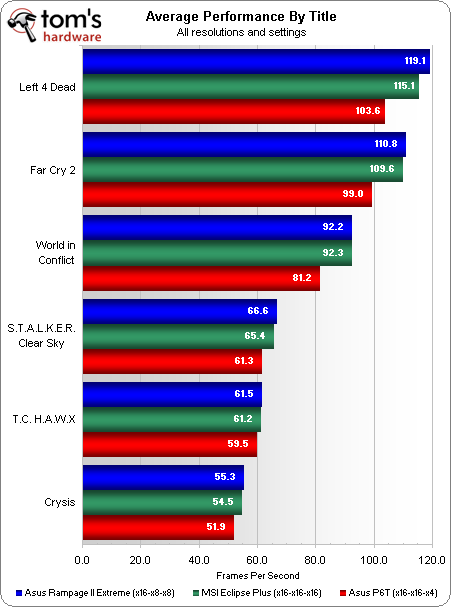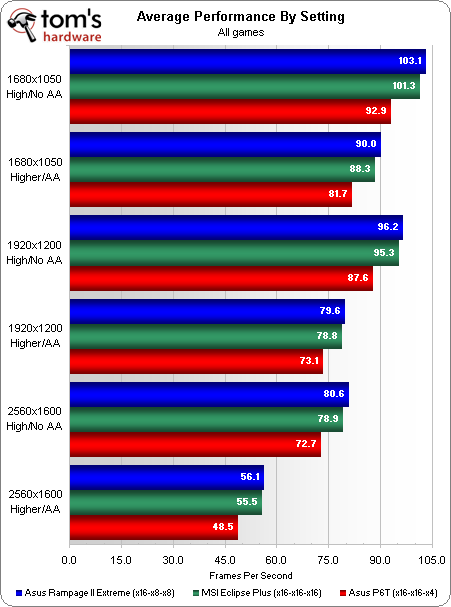MSI Eclipse Plus: Does nForce 200 Boost 3-Way SLI?
Performance Analysis And Conclusion
Calculating average performance per game will help us to see which titles most heavily favor high-bandwidth slots.
Left 4 Dead appears to be the most significantly bandwidth-limited game, but we had previously noticed an oddity that almost disqualifies the game from further analysis. A combination of lower-bandwidth (P6T) and added PCIe latency (Eclipse Plus) could be what threw our expectations out-the-window for that title, but there’s no way of knowing the exact cause. World In Conflict appears more appropriate for analyzing the performance penalty of the P6T’s x4-width third slot, while also showing that two slots sharing sixteen pathways (Eclipse Plus) have the same performance as two x8 slots.
If bandwidth limitations to the second and third graphics card are the biggest part of today’s story, we’d expect the problem to increase with higher resolutions and details. Is this the case?
A performance difference of around 10% between the fastest and slowest PCIe configurations climbs to nearly 16% at the highest tested settings.
Conclusion
Tom’s Hardware doesn’t do many single-motherboard reviews, simply because it’s impossible to give every company that level of attention when faced with dozens of samples per year. Yet MSI provided an opportunity we couldn’t pass up: to access the gaming performance advantage of two shared x16 slots compared to two dedicated x8 slots. Unfortunately, we found no substantial advantage, though the Eclipse Plus remains a great motherboard in many ways that would only be completely revealed in a full review.
The real revelation of today’s article is the level of handicap an x4 slot places on the third graphics card in a 3-way SLI configuration, even with PCIe 2.0 doubling its bandwidth. We knew it would be bad, but not this bad, and the results force us to cross the Asus P6T, the DFI X58-T3eH6, MSI’s previous Eclipse SLI, and several as-yet-untested products off our 3-way SLI list. If MSI’s intent was to show how much better the Eclipse Plus is for 3-way SLI than its x16-x16-x4 predecessor, we can give the company credit for that.
Get Tom's Hardware's best news and in-depth reviews, straight to your inbox.
What we didn’t see today, however, was whether or not three true x16 slots would provide any advantage at all over an x16-x8-x8 configuration. The reason, of course, is that the only Core i7 chipset doesn’t have the required 48 PCIe lanes, and adding a hub to “make” an x16-x16-x16 configuration leaves us with only as much bandwidth as the 32-lanes serving those three slots.
We can imagine some “Home Supercomputer” applications where Nvidia’s CUDA technology might need to access various graphics processors at different times, where the flexibility of sixteen shared pathways might be advantageous compared to two sets of eight pathways especially if three GTX 295s are used. After all, a GTX 295 on a x8 slot would only have four lanes of bandwidth per GPU. But MSI doesn’t target high-end-workstations and above with this particular motherboard, leaving that market to the competing and yet-unexamined Asus P6T6 WS Revolution. Instead it follows the path of the also-yet-unexamined EVGA X58 Classified, marketing to gamers a board that has yet to reveal any gaming advantage.
Perhaps a shootout of nForce 200-equipped X58 motherboards should be arranged, but until then, we’ll stick with the chipset-supported x16-x8-x8 configuration for our own 3-way SLI tests.
Current page: Performance Analysis And Conclusion
Prev Page Benchmark Results: 3DMark Vantage, Power Consumption-
Proximon Interesting results to be sure, but now I want to know how much performance difference there is with just a single card. I kind of feel there is a control lacking because we don't see how just the single X16 performs in each case.Reply
Still, the consistent performance of the top end boards make me a believer, I just would have liked that baseline to see if there were any other factors at work. -
curnel_D ProximonInteresting results to be sure, but now I want to know how much performance difference there is with just a single card. I kind of feel there is a control lacking because we don't see how just the single X16 performs in each case.Still, the consistent performance of the top end boards make me a believer, I just would have liked that baseline to see if there were any other factors at work.Reply
By the data presented, we can pretty much gather that it'd be very close to the same. It's the same chipset controling the first slot on both boards, while the Nforce controler takes over the second and third on the msi. So there's really no point in benching a motherboard for something it wasnt designed for. -
phatboe Honestly I'm sick of Intel, I want them to allow NVidia to make core i7 chipsets so that we can see some kind of competition in chipsets.Reply -
apache_lives phatboeHonestly I'm sick of Intel, I want them to allow NVidia to make core i7 chipsets so that we can see some kind of competition in chipsets.Reply
Nvidia chipsets are no match to Intel chipsets (drivers, overclocking, stability, reliability), and with Intel having SLI support theres no point in an Nvidia chipset.
As for MSI - i wouldnt even spend $50 on an MSI product let alone this product - they are RUBBISH cheap crap poorly designed products. -
SpadeM This reminds me of an article waaaaaay back, actually 2 articlesReply
1. http://www.tomshardware.com/reviews/nvidia-7800gs-confirms-agp-aint-dead,1213-2.html
and
2. http://www.tomshardware.com/reviews/pci-express-scaling-analysis,1572.html
I'd be grateful if you could revisit the second one, since GTX285/GTX295 + HD4890/HD4870X2 are with us now, and there's PCIe 2.0.
I know that things probably wouldn't have changed much since that article since PCIe 2.0 goes 2xPCIe link speed so it is simple math to get some numbers but, still, it might be worth looking into since new chipsets and processors are available also.
Anyways thanks for the good read. -
Ramar apache_livesAs for MSI - i wouldnt even spend $50 on an MSI product let alone this product - they are RUBBISH cheap crap poorly designed products.Reply
I've got several friends running MSI boards that they love and have been running for years. They don't look like much but I've never seen one pop a cap or anything. -
neiroatopelcc apache_livesAs for MSI - i wouldnt even spend $50 on an MSI product let alone this product - they are RUBBISH cheap crap poorly designed products.Really? Have you ever had one?Reply
I've used msi boards now and then at least since canterwood, but have yet to see a single board that is rubbish - or cheap. The designs are usually superior to asus, but then apart from support that is asus' single biggest weakness.
Overall the ONLY bad thing I can say about msi is the lack of active cooling on their 790GX boards. They do run without active cooling, but they run so much cooler with it. I usually end up running a socket a fan @ 7v on the chipset heatsink on those boards just to be sure I won't have to look at them again in a few years because they died. -
scook9 The nForce 200 is simply a marketing ploy by nvidia, that until today was working. This article exposes the shortcoming of it, you cant make something from nothing, you will still be limited by the original PCIe lanes off the northbridge. And sadly - for the extreme high end user, I don't see northbridges with 48+ PCIe 2.0 lanes coming any time soon.Reply
I really wish Intel had played nice with nvidia and gotten us SLI on x38/x48, or maybe try to retroactively garner that ability. I have always preferred Intel's chipsets to Nvidia's. The nforce chips just can't overclock worth a dam. I mean really, who better to make a chipset for a CPU than the CPU designer.
After this article I am still pretty happy with my Rampage II GENE and its x16-x16 SLI (GTX 275s). I only play on a 24" screen, so I can't justify 3 way SLI at all.
If Tom's gets some spare time, I would like to see a 1x vs. 2x. vs. 3x SLI comparison, to see just how well the drivers actually scale.


